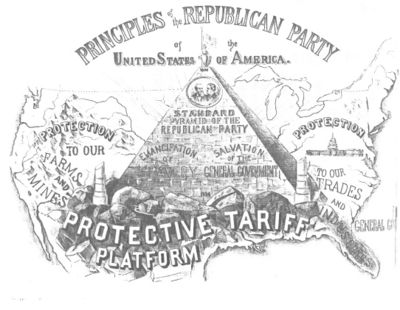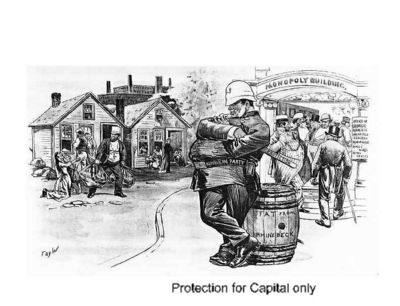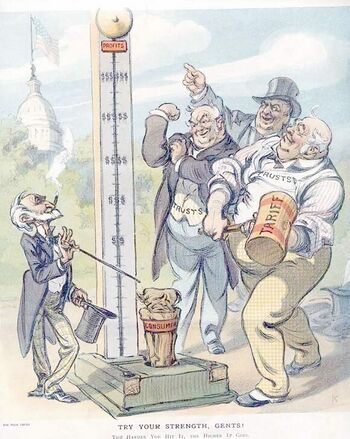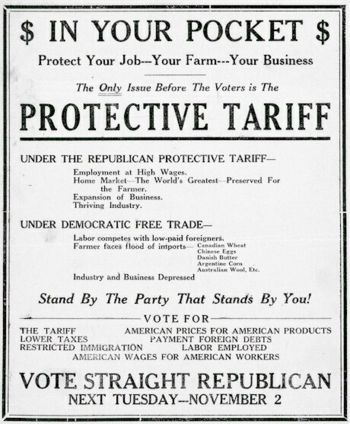Tariff, U.S. history
The tariff is a tax on an imported product that generates revenue, protects American producers of that product, and created a major political issue in American history from the founding of the nation to the present.
There are two sides to the history of tariffs in the economic history of the United States and the role they have played in U.S. trade policy. In the first place, it was the single most important source of federal revenue from the 1790s to the eve of World War I, when it was finally surpassed by income taxes. So essential was this revenue source, and so easy was it to collect at the major ports, that all sides agreed that the nation should have a tariff for revenue purposes. In practice, that was an average tax of about 20% of the value of most imported goods. (Imports that were not taxed were "free".)
The second issue was protection to industry; this was the political dimension of the tariff. From the 1790s to the 2000s, the tariff (and closely related issues such as import quotas and trade treaties) have generated enormous political stresses. For a brief moment in 1832 South Carolina made vague threats to leave the Union over the tariff issue. In the 1850s the southerners controlled tariff policy, keeping it low (thus it was not a reason for secession).
1789 to 1828
The Tariff Act of 1789 imposed the first national source of revenue for the newly formed United States. The new Constitution allowed only the federal government to levy tariffs, so the old system of state rates disappeared. The new law taxed all imports at rates from 5 to 15 percent. These modest rates were primarily designed to generate revenue to pay the national debt and annual expenses of the federal government. In his Report on Manufactures Treasury Secretary Alexander Hamilton proposed a far-reaching scheme to use protective tariffs as a lever for rapid industrialization. His proposals were not adopted.
The high protectionism Hamilton called for was not adopted until after the War of 1812 when nationalists like Henry Clay and John C. Calhoun wanted more industry so the nation would have a balanced economy. In wartime, they declared, having a home industry was a necessity. Likewise owners of the small new factories that were springing up in the northeast to produce boots, hats, candles, nails and other common items failed to obtain higher tariffs that would significantly protect them from more efficient British producers. A 10% discount on the tax was offered on items imported in American ships, so that the American merchant marine would be supported.
Once industrialization started, the demand for higher and higher tariffs came from manufacturers and factory workers. They believed that Americans should be protected from the low wages of Europe. Every Congressman was eager to logroll a higher rate for his local industry. Senator Daniel Webster, formerly a spokesperson for Boston's merchants who imported goods (and wanted low tariffs), switched dramatically to represent the manufacturing interests in the Tariff of 1824. Rates were especially high for bolts of cloth and for bar iron, of which Britain was a low-cost producer. The culmination came in the Tariff of 1828, ridiculed by free traders as the "Tariff of Abominations", with duties averaging over 50 percent. Intense political reaction came from South Carolinians, who concluded that they would pay more for imports and sell less cotton abroad, so their economic interest was being unfairly injured. They attempted to "nullify" the federal tariff and spoke of secession (see the Nullification Crisis). The compromise that ended the crisis included a lowering of the tariff over ten years to a uniform 20% in 1842.
Tariff 1828-60
Henry Clay and his Whig Party, envisioning a rapid modernization based on highly productive factories, sought a high tariff. Their key argument was that startup factories, or "infant industries," would at first be less efficient than European (British) producers. Furthermore, American factory workers would be paid higher wages than their European competitors. The arguments proved highly persuasive in industrial districts. Clay's position was adopted in the Tariffs of 1828 and 1832.
John C. Calhoun in his South Carolina Exposition and Protest rejected the idea that government policies designed to benefit one section at the expense of another was good government policy. This led protracted southern resistance leading to the Nullification Crisis which forced the Whigs to abandon higher tariffs until 1842. When the Whigs won victories in the 1840 and 1842 elections, taking control of Congress, they re-instituted higher tariffs with the Tariff of 1842.
The Democrats won in 1844, electing James K. Polk as president. Polk succeeded in passing the Walker tariff of 1846 by uniting the rural and agricultural factions of the country for lower taxes. These sections sought a "tariff for revenue only" that would pay the cost of government but not show favoritism to one section or economic sector at the expense of another. The Walker Tariff remained in place until 1857, when a nonpartisan coalition lowered import duties to 18 percent with the Tariff of 1857. The United States thus had a low-tariff policy that favored the South until the Civil War began in 1861.
Civil War Protective Policy, 1861-1913
The Panic of 1857 was blamed by many former Whigs and industrialists on the free trade policy of the 1857 law. Legislators such as Justin Morrill and economist Henry Carey began to push for a restoration of the Whig American System program of protective tariffs. War was at hand and the Union urgently needed revenues. With the Southern senators gone, Congress passed the Morrill Tariff in early 1861; it took effect a few days before the war began, and was not collected in the South. The Confederate States of America passed its own tariff of 15% on most items, including all items that previously were duty-free from the North.
As the American Civil War became a major conflict Washington needed vast revenues. The Morrill Tariff was revised upward twice more between 1861 and 1862. With the low-tariff southerners gone, the Republican-controlled Congress doubled and tripled the rates on European goods, which topped out at 49 percent in 1868.
Throughout the Civil War the Confederacy was under a blockade by the Union Navy. The Confederacy imposed a taridd of 15%, and extended it to cover all goods imported from the U.S. It was a stunning increase in taxes, for nearly all the South's manufactured products had previously been imported free from the North. However it did not matter for few people paid any taxes on illegal trade and smuggled goods, so the Confederacy collected a mere $3.5 million in tariff revenue from the start to end and had to resort to inflation and confiscation instead to pay for its war.
After the war, high tariffs remained. Advocates insisted that tariffs brought prosperity to the nation as a whole and no one was really injured. As industrialization proceeded apace throughout the Northeast, some Democrats, especially Pennsylvanians, became high tariff advocates. The Republican high tariff advocates appealed to farmers with the theme that high-wage factory workers would pay premium prices for foodstuffs. This was the "home market" idea, and it won over most farmers in the Northeast, but it had little relevance to the southern and western farmers who exported most of their cotton, tobacco and wheat.
Wool
In the late 1860s the wool manufacturers (based near Boston and Philadelphia) formed the first national lobby, and cut deals with wool-growing farmers in several states. Their challenge was that fastidious wool producers in Britain and Australia marketed a higher quality fleece than the careless Americans, and that British manufacturers had costs as low as the American mills. The result was a wool tariff that helped the farmers by a high rate on imported wool—a tariff the American manufacturers had to pay—together with a high tariff on finished woolens and worsted goods. Apart from wool and woolens, American industry and agriculture—and industrial workers—had become the most efficient in the world by the 1880s. They were not at risk from cheap imports.
Iron
Irwin (2000) estimates that if the high tariff on imported iron had been dropped as early as 1869, American producers would have lost about 15% of their market and imports would have risen from about 7% to 30% of the market. Under these conditions most domestic pig-iron firms would have survived. [1] No other country had the industrial capacity, the high efficiency and low costs, or the complex distribution system needed to compete in the vast American market. Indeed, it was the British who watched in stunned horror as cheaper American products flooded their home islands. Wailed the London Daily Mail in 1900,
"We have lost to the American manufacturer electrical machinery, locomotives, steel rails, sugar-producing and agricultural machinery, and latterly even stationary engines, the pride and backbone of the British engineering industry."
Nevertheless American manufacturers and workers demanded the high tariff be maintained. The tariff represented a complex balance of forces. Railroads, for example, consumed vast quantities of steel. To the extent tariffs raised steel prices, they felt injured. The Republicans became masters of negotiating exceedingly complex arrangements so that inside each of their congressional districts there were more satisfied "winners" than disgruntled "losers." The tariff after 1880 was an ideological relic with no economic rationale—it was a timebomb waiting to explode—and it repeatedly did explode.
Democratic president Grover Cleveland redefined the issue in 1887, with his stunning attack on the tariff as inherently corrupt, opposed to true republicanism, and inefficient to boot: "When we consider that the theory of our institutions guarantees to every citizen the full enjoyment of all the fruits of his industry and enterprise... it is plain that the exaction of more than [minimal taxes] is indefensible extortion and a culpable betrayal of American fairness and justice." The election of 1888 was fought primarily over the tariff issue, and Cleveland lost. Republican Congressman William McKinley argued,
"Free foreign trade gives our money, our manufactures, and our markets to other nations to the injury of our labor, our tradespeople, and our farmers. Protection keeps money, markets, and manufactures at home for the benefit of our own people."
McKinley's high tariff 1890-1910
Democrats campaigned energetically against the high McKinley tariff of 1890, and scored sweeping gains that year; they restored Cleveland to the White House in 1892. The severe depression that started in 1893 destroyed the Democratic party. Cleveland and the Bourbon Democrats insisted on a much lower tariff. His problem was that Democratic electoral successes had brought in Democratic congressmen from industrial districts who were willing to raise rates to benefit their districts. The Wilson-Gorman Tariff Act of 1894 did lower overall rates from 50 percent to 42 percent, but contained so many concessions to protectionism that Cleveland refused to sign it. McKinley campaigned heavily in 1896 on the tariff as a positive solution to depression. Promising protection and prosperity to every economic sector, he won a smashing victory. The Republicans rushed through the Dingley tariff in 1897, boosting rates back to the 50 percent level. Democrats responded that the high rates created "trusts" (monopolies) and led to higher consumer prices. McKinley won reelection by an even bigger landslide and started talking about a post-tariff era of reciprocal trade agreements. Reciprocity went nowhere; McKinley's vision was a half century too early.
Crisis of 1910
The delicate balance flew apart on president William Howard Taft's watch. Taft campaigned in 1908 for tariff "reform," which everyone assumed meant lower rates. The House lowered rates with the Payne Bill, then sent it to the Senate where Nelson Wilmarth Aldrich worked his sleight of hand. Whereas Aldrich was a New England businessman and a master of the complexities of the tariff, the Midwestern Republican insurgents were rhetoricians and lawyers who distrusted the special interests and assumed the tariff was sheer robbery for the benefit of fat cats at the expense of the ordinary consumer. Rural America believed that its superior morality deserved special protection, while the dastardly immorality of the trusts—and cities generally—merited financial punishment. Aldrich baited them. Did the insurgents want lower tariffs? His wickedly clever Payne-Aldrich Tariff Act of 1909 lowered the protection on Midwestern farm products, while raising rates favorable to his Northeast.
Tariff with Canada
The Canadian-American Reciprocity Treaty increased trade between 1855 and its ending in 1866. When it ended Canada turned to tariffs. The National Policy was a Canadian economic program introduced by John A. Macdonald's Conservative Party in 1879 after it returned to power. It had been an official policy, however, since 1876. It was based on high tariffs to protect Canada's manufacturing industry. Macdonald campaigned on the policy in the 1878 election, and handily beat the Liberal Party, which supported free trade.
Efforts to restore free trade with Canada collapsed when Canada rejected a proposed reciprocity treaty in fear of American imperialism in the Canadian federal election, 1911. Taft negotiated a reciprocity agreement with Canada, that had the effect of sharply lowering tariffs. Democrats supported the plan but Midwestern Republicans bitterly opposed it. Barnstorming the country for his agreement, Taft undiplomatically pointed to the inevitable integration of the North American economy, and suggested that Canada should come to a "parting of the ways" with Britain. Canada's Conservative Party now had an issue to regain power from the low-tariff Liberals; after a surge of pro-imperial anti-Americanism, the Conservatives won. Ottawa rejected reciprocity, reasserted the National Policy and went to London first for new financial and trade deals. The Payne Aldrich Tariff of 1909 actually changed little and had slight economic impact one way or the other, but the political impact was enormous. The insurgents felt tricked and defeated and swore vengeance against Wall Street and its minions Taft and Aldrich. The insurgency led to a fatal split down the middle in 1912 as the GOP lost its balance wheel.
Low tariff policy, 1913 to present
Woodrow Wilson made a drastic lowering of tariff rates a major priority for his presidency. The 1913 Underwood Tariff cut rates, but the coming of world war in 1914 radically revised trade patterns. Reduced trade and, especially, the new reveues generated by the federal income tax made tariffs much less important. When the Republicans regained power after the war they restored the usual high rates.
Great Depression and Smoot-Hawley tariff of 1930
Farm prices were depressed in the 1920s and many farm groups endorsed the McNary-Haugen Bill for protecting domestic farm prices through a tariff and the sale of surpluses abroad at world prices. It was vetoed by Presidernt Calvin Coolidge, who wanted farmers to modernize their operations rather than depend on market manipulation.
The Great Depression was worldwide, and international trade shrank drastically. The crisis baffled the GOP, and it unwisely tried its magic one last time in the Smoot-Hawley Tariff Act of 1930. This time it backfired. Canada--the leading trading partner--not only raised its tariffs but forged closer economic links within British Commonwealth, and US-Canada trade plunged. France and Britain protested and developed new trade avenues oriented toward their empires. Germany developed a system of autarky in central Europe. American imports plunged two-thirds from $4.4 billion (1929) to $1.5 billion (1933), exports fell from $5.4 billion to $2.1 billion, in both cases far more than the 50% fall in GDP. The tremendous drop in foreign trade was a stunning shock to the proponents of Smoot-Hawley, and effectively destroyed advocacy of high tariffs in the US.[2]
New Deal and reciprocity
Franklin Roosevelt and the New Dealers made promises about lowering tariffs on a reciprocal country-by-country basis (which they did), hoping this would expand foreign trade (which it did not). Frustrated, they gave much more attention to domestic remedies for the depression; by 1936 the tariff issue had faded from politics, and the revenue it raised was small.
Schnietz (2000) analyzes the Reciprocal Trade Agreements Act of 1934, the foundation of modern US trade policy. This act gave the president power to set tariffs without congressional approval, subject to recertification by Congress every three years. In essence, this act made possible the modern era of free trade that has dominated the post-World War II era. Congress's delegation of authority to the president departed drastically from historical precedent in response to the unique circumstances of the Great Depression. The dominant explanation has been that Congress learned from the disaster of the Smoot-Hawley Tariff, but the act's swift passage was more likely due to the Franklin D. Roosevelt administration's leadership and party politics. Democrats in Congress also supported the act because it promised greater protection for the party's free trade prerogatives against typical reversals by protectionist Republicans in later years.
In World War II both tariffs and reciprocity were insignificant compared to trade channeled through Lend Lease.
Post World War II
After the war the U.S. promoted the General Agreement on Tariffs and Trade (GATT) established in 1947, to minimize tariffs and other restrictions, and to liberalize trade among all capitalist countries. In 1995 GATT became the World Trade Organization WTO; with the collapse of Communism its open markets/low tariff ideology became dominant worldwide in the 1990s.
American industry and labor prospered after World War II, but hard times set in after 1970. For the first time there was stiff competition from low-cost producers around the globe. Many rust belt industries faded or collapsed, especially the manufacture of steel, TV sets, shoes, toys, textiles and clothing. Toyota and Nissan threatened the giant domestic auto industry. In the late 1970s Detroit and the auto workers union combined to fight for protection. They obtained not high tariffs, but a voluntary restriction of imports from the Japanese government. Quotas were two-country diplomatic agreements that had the same protective effect as high tariffs, but did not invite retaliation from third countries. By limiting the number of Japanese automobiles that could be imported, quotas inadvertently helped Japanese companies push into larger, and more expensive market segments. The Japanese producers, limited by the number of cars they could export to America, opted to increase the value of their exports to maintain revenue growth. This action threatened the American producers' historical hold on the mid- and large-size car markets.
1980s to present
The GOP under Ronald Reagan and George H.W. Bush abandoned the protectionist ideology, and came out against quotas and in favor of the GATT/WTO policy of minimal economic barriers to global trade. Free trade with Canada came about as a result of the Canada-U.S. Free Trade Agreement of 1987, which led in 1994 to the North American Free Trade Agreement, NAFTA. It was based on George H. W. Bush's plan to enlarge the scope of the market for American firms to include Canada and Mexico. President Bill Clinton, with strong Republican support, pushed NAFTA through Congress over the vehement objection of labor unions. Likewise in 2000 he worked with Republicans to give China entry into WTO and "most favored nation" trading status (i.e., low tariffs). NAFTA and WTO advocates promoted an optimistic vision of the future, with prosperity to be based on intellectuals skills and managerial know-how more than on routine hand labor. They promised that free trade meant lower prices for consumers. It also meant lower wages and fewer jobs in older industries that could no longer compete. Opposition to liberalized trade came increasingly from labor unions, but their shrinking size and diminished political clout repeatedly left them on the losing side.
See also
Bibliography
- Archibald, Robert B. and David H. Feldman. "Investment during the Great Depression: Uncertainty and the Role of the Smoot-Hawley Tariff," Southern Economic Journal, Vol. 64, (1998) online edition
- Ashley, Percy, Modern Tariff History: Germany - United States - France (2006) 312 pages
- Clark, Victor Selden. History of Manufactures in the United States (1916) massive study of every industry online edition
- Dewey, Davis Rich. Financial History of the United States (1902) 530 pages online edition
- Doran, Charles F. and Gregory P. Marchildon. The NAFTA Puzzle: Political Parties and Trade in North America (1994)
- Eckes, Alfred. Opening America's Market: U.S. Foreign Trade Policy since 1776 (1995)
- Kaplan, Edward S. and Thomas W. RyleyPrelude to Trade Wars: American Tariff Policy, 1890-1922 (1994) 150pp online edition
- Kaplan, Edward S. American Trade Policy: 1923-1995 (1996), online review; complete text
- Reitano, Joanne R. The Tariff Question in the Gilded Age: The Great Debate of 1888 (1994), covers debate on Mills Tariff of 1888 that did not pass Congress.
- Smith; Mark A. The Tariff on Wool (1926) online edition
- Schattsneider, E. E. Politics, Pressures and the Tariff (1935). Passage of Hawley-Smoot tariff
- Schnietz, Karen E. "The Institutional Foundation of U.s. Trade Policy: Revisiting Explanations for the 1934 Reciprocal Trade Agreements Act." Journal of Policy History 2000 12(4): 417-444. Issn: 0898-0306 Fulltext: in Project Muse
- Stanwood, Edward. American Tariff Controversies in the nineteenth century. (1903), political narrative, online edition
- Tarbell, Ida M. The Tariff in Our Times 1911
- Taussig, F. W. Some Aspects of the Tariff Question: An Examination of the Development of American Industries Under Protection (1931)
- Taussig, F. W. The Tariff History of the United States. 8th edition (1931); [5th edition 1910 is online 6th edition 1914 online
- Taussig, F.W. "Tariff," Encyclopedia Britannica (11th edition, 1911) vol 26
- Taylor, George Rogers, ed. The Great Tariff Debate, 1820-1830 (1953), excerpts from primary and secondary sources online edition
- Terrill, Tom E. The Tariff, Politics, and American Foreign Policy 1874-1901 (1973).
- Summers, Festus P. William L. Wilson and Tariff Reform, a Biography (1953) online edition
- Turney, Elaine C. Prange, and Cynthia Clark Northrup, eds. eds. Tariffs and Trade in U.S. History: An Encyclopedia 3 vol. (2003) vol 2 online
- Wolman, Paul. Most Favored Nation: The Republican Revisionists and U.S. Tariff Policy, 1897-1912 (1992) excerpt and text search
Primary sources
- F.W. Taussig, ed. State Papers and Speeches on the Tariff, (1892) 385 pages online edition
- Taylor, George Rogers, ed. The Great Tariff Debate, 1820-1830 (1953), excerpts from primary and secondary sources online edition
- Turney, Elaine C. Prange, and Cynthia Clark Northrup, eds. eds. Tariffs and Trade in U.S. History: An Encyclopedia (2003) [http://www.questia.com/read/106901809 vol 3. is documents; online version
- ↑ Douglas A. Irwin, "Could the United States Iron Industry Have Survived Free Trade after the Civil War?" Explorations in Economic History 2000 37(3): 278-299. Issn: 0014-4983
- ↑ Judith A. McDonald, Anthony Patrick O'Brien and Colleen M. Callahan, "Trade Wars: Canada's Reaction to the Smoot-hawley Tariff." Journal of Economic History 1997 57(4): 802-826. Fulltext: in Jstor




